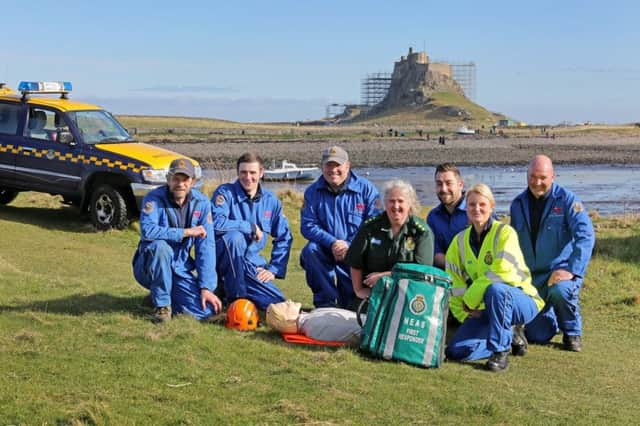First responders launched on Holy Island


Co-responders and Community First Responders (CFRs) volunteer to help NEAS by responding to life-threatening emergencies within their community prior to the arrival of an ambulance.
Working closely with the HM Coastguard, the parish council and local residents, NEAS has now provided training for six co-responders to deal with first-aid emergencies on the island.
Advertisement
Hide AdAdvertisement
Hide AdResponders are often everyday members of the general public who are trained by NEAS in basic first aid and life support. They are provided with oxygen and a defibrillator and are deployed by NEAS to life-threatening emergencies, such as chest pain, breathing difficulties, cardiac arrest and unconsciousness, if they are the nearest resource, followed by the next nearest emergency care crew.
They exist in cities, towns and villages where it may be a challenge for the emergency ambulance to arrive within the crucial first few minutes. Their aim is to provide immediate care to a patient where every second counts; a patient who suffers a cardiac arrest stands a much better chance of survival if someone with a defibrillator can attend the patient in the first minutes of collapse.
Alex Mason, NEAS community development officer, said: “Holy Island is an island cut off from the main land twice a day by the tide, with a population of around 160 permanent residents with hundreds of thousands of visitors. In the event of any incidents on the island, we already work closely with the HM Coastguard to agree the best option for access to and from the island be that land, sea or air. However, having responders on the island will provide even more support to patients and our crews.”
Kyle Luke, Coastguard Rescue Officer, who owns the Crown and Anchor pub, said: “We have seen this weekend just how difficult it can be to get access to the island during an emergency. Having CFRs who are able to deal with situations when the emergency services can’t get to the patient easily is massively beneficial to us.”
Advertisement
Hide AdAdvertisement
Hide AdNow trained, the new team have been issued with standard equipment including an automated defibrillator, oxygen, suction unit and simple airways adjuncts. They are also issued with a range of medical consumables, such as dressings.
Alex added: “When HM Coastguard staff are on station, they will log on to show that they are available and in the event of an ambulance being unable to access Holy Island or to get immediate care to the casualty, the co-responders can be paged by the HM Coastguard operations room and communicate directly with us.”
The Island community already has access to a community public-access defibrillator (CPAD), with a number of residents who are trained in its use.
A spokesman from Holy Island Parish Council said: “We are delighted by the completion of this training. Since the removal of the Boulmer helicopter, we have been in regular dialogue with NEAS and the HM Coastguard to ensure that the emergency Services can reach the island quickly at high tide and in bad weather.
Advertisement
Hide AdAdvertisement
Hide Ad“Having resources based on the island with a number of islanders trained in their use is really important. This is greatly welcomed and our thanks go to HM Coastguard, NEAS and in particular to the volunteers themselves.”
In 2016, there was 26,341 life-threatening or potentially life-threatening incidents in the Northumberland Clinical Commissioning Group (CCG) area. Of those, 1,477 were responded to by CFRs from schemes in Berwick, Belford, Wooler and Seahouses.
As well as the CFR schemes, there are also more than 75 public-access defibrillators across Northumberland, with hundreds of members of the community trained by NEAS to undertake basic first aid.
Alex added: “A responder’s role may be to simply provide vital reassurance to patients and their families, but in extreme cases such as a cardiac arrest, they will be able to perform CPR and use a defibrillator to deliver a shock to the person’s heart that will make an enormous difference their patient’s chance of survival and the quality of their life in recovery.”